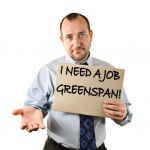 Last Friday the Bureau of Labor Statistics released their September jobs Report. The unemployment rate rose to 9.8%, up 0.1% from August and the U.S. economy shed 263,000 jobs for the month. While these numbers were higher than expected, the general trend is well established. Job losses are still mounting.
Last Friday the Bureau of Labor Statistics released their September jobs Report. The unemployment rate rose to 9.8%, up 0.1% from August and the U.S. economy shed 263,000 jobs for the month. While these numbers were higher than expected, the general trend is well established. Job losses are still mounting.
Speaking with ABC’s This Week, former Fed Chairman Alan Greenspan talked about how unemployment will be “penetrating” the 10% barrier. Greenspan typically recites government/Federal Reserve talking points on economic matters. When he says unemployment will hit 10%, expect it – and then some. However, he isn’t telling the whole story. As we mentioned earlier, his numbers do not include marginally attached workers, those working part-time for economic reasons, or discouraged workers. Add those categories and the broader unemployment rate was 17% in September. You can expect even more when Greenspan’s traditional 10% comes to pass.
Most economists regard unemployment as a lagging economic indicator. This means rising unemployment does not necessarily mean the economy is getting worse. The economy could be improving even as employers lay off more workers. Greenspan is clearly from this school of thought. In the same show where he predicts 10% unemployment, he suggested we’ve emerged from the recession and said he expects 3% GDP growth for the 3rd quarter. No doubt consecutive quarters of contraction will eventually give way to growth. But unemployment “penetrating” 10% is usually not considered a positive economic indicator – especially for the unemployed.
Maybe unemployment is a lagging indicator, but rising unemployment certainly does not suggest optimistic employers. Basic economic common sense suggests when employers expect opportunity in their business, they hire. When they are fearful of the future, they scale back. Since labor is one of the bigger expenses for most businesses, jobs are often cut in economically difficult times. In other words, negative business expectations result in rising unemployment.
Of course, employers can be wrong. But they are also the “boots on the ground” in the economy. If businesses perceive difficult times ahead, they contract and cut costs however they can. Most do not stop to ask Alan Greenspan if their perception is a lagging economic indicator.
Investors should take note of this trend. Official unemployment is now in the early-1980’s range and Alan Greenspan thinks it will continue to rise. Construction, manufacturing, and retail trades are suffering the most. The impact is spilling through the economy. Think about this before you make any bullish bets.